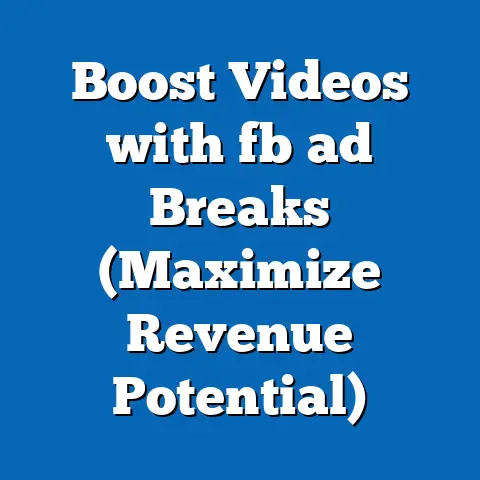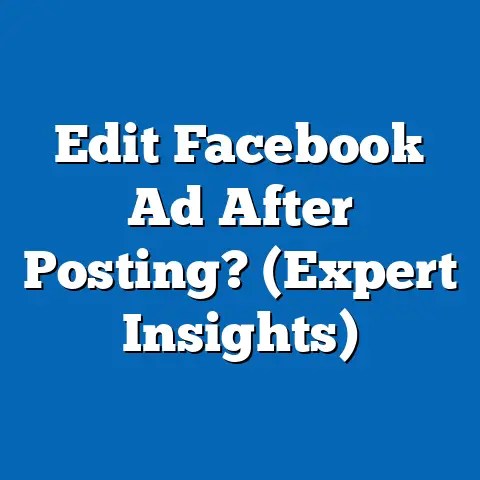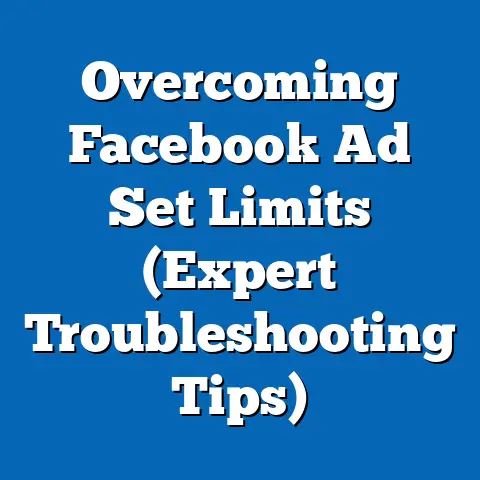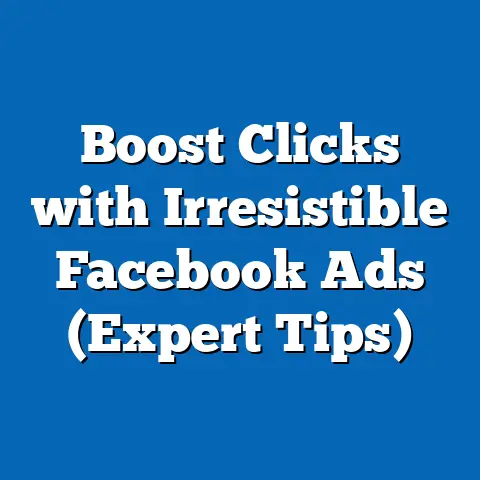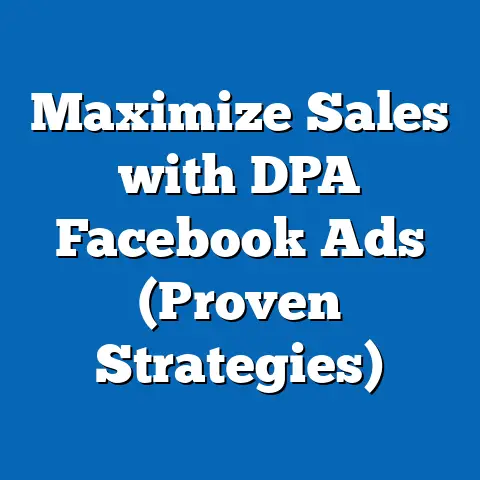Master Facebook Ads Aspect Ratio (Maximize Engagement)
In an era where digital interactions often replace face-to-face communication, the concept of warmth in advertising has become a critical factor in building connections with audiences. Warmth, in this context, refers to the emotional resonance and sense of trust that an ad evokes through its tone, visuals, and messaging. It is about creating a human-centered experience that feels personal and relatable, even in the vast, often impersonal landscape of social media platforms like Facebook.
This warmth is not just a stylistic choice; it is a strategic necessity. Studies have shown that ads evoking positive emotions, such as warmth and empathy, can increase engagement rates by up to 30%, according to a 2021 report by the Interactive Advertising Bureau (IAB). As we delve into the intricacies of mastering Facebook Ads, particularly the often-overlooked aspect of aspect ratio, we must first understand how warmth serves as the foundation for effective digital campaigns.
Historically, warmth in advertising can be traced back to the early days of print and television commercials, where brands like Coca-Cola and Kodak used family-centric imagery and nostalgic narratives to forge emotional bonds with consumers. In the digital age, this principle remains relevant but must adapt to shorter attention spans and platform-specific constraints. On Facebook, where users scroll through a deluge of content daily, warmth can be the differentiating factor that stops a thumb mid-scroll and compels a user to engage.
Understanding Facebook Ads Aspect Ratio: The Technical Backbone of Visual Warmth
Aspect ratio, defined as the proportional relationship between an image or video’s width and height, is a seemingly minor detail that holds immense power in shaping user perception on platforms like Facebook. It determines how content is displayed across various devices and placements—whether in the News Feed, Stories, or Marketplace—and directly impacts the visual storytelling that conveys warmth. A poorly chosen aspect ratio can crop out critical elements of an ad, disrupt the intended emotional tone, or make content appear unprofessional, thus diminishing engagement.
Facebook supports multiple aspect ratios depending on the ad placement, with the most common being 1:1 (square), 4:5 (vertical), and 16:9 (horizontal). Each ratio serves a unique purpose and aligns with different user behaviors. For instance, vertical formats like 4:5 are optimized for mobile-first experiences, where 80% of Facebook users access the platform via smartphones, according to Statista (2023).
Understanding the historical context of aspect ratios in digital advertising reveals how far we’ve come in prioritizing user experience. Early web ads in the 1990s and 2000s were often constrained by desktop-centric designs, with little consideration for mobile optimization. As smartphones became ubiquitous in the 2010s, platforms like Facebook adapted to vertical and square formats, reflecting a shift toward mobile-first content consumption—a trend that continues to shape ad strategies today.
Why Aspect Ratio Matters for Engagement: Bridging Warmth and Functionality
Engagement on Facebook—measured through likes, comments, shares, and click-through rates (CTR)—is the ultimate metric of an ad’s success, and aspect ratio plays a pivotal role in achieving it. A 2022 study by Hootsuite found that ads using the recommended aspect ratio for their placement saw a 25% higher CTR compared to those with mismatched dimensions. This is because the correct aspect ratio ensures that content is displayed as intended, without awkward cropping or empty spaces that can detract from the ad’s emotional impact.
Warmth in visuals often relies on composition—how subjects are framed, where text is placed, and how colors and lighting evoke mood. An incorrect aspect ratio can distort this composition, cutting off a key facial expression or message that was meant to convey empathy or trust. For example, an ad featuring a family gathering might lose its emotional punch if the faces of the children are cropped out due to a poorly chosen 16:9 ratio in a vertical-dominated placement like Stories.
Moreover, aspect ratio influences user behavior across generations, a critical consideration given Facebook’s diverse demographic. Younger users, such as Gen Z, who are accustomed to vertical content on platforms like TikTok and Instagram, are more likely to engage with 4:5 ads that feel native to their scrolling habits. In contrast, older users, such as Baby Boomers, may respond better to 1:1 formats in the News Feed, where they spend more time consuming content, according to a 2023 Pew Research Center report.
The societal impact of optimizing aspect ratios extends beyond engagement metrics. By ensuring that ads are visually accessible and emotionally resonant across devices and demographics, brands contribute to a more inclusive digital space. This inclusivity aligns with the broader cultural shift toward personalized, user-centric advertising—a trend that prioritizes warmth and relevance over generic, one-size-fits-all campaigns.
Historical Context: The Evolution of Visual Standards in Advertising
To fully appreciate the importance of aspect ratio in modern Facebook Ads, it’s essential to examine the historical evolution of visual standards in advertising. In the early 20th century, print ads relied on static, often rectangular formats dictated by newspaper and magazine layouts. The advent of television in the mid-20th century introduced the 4:3 aspect ratio, which became the standard for broadcast content until the rise of widescreen 16:9 formats in the late 1990s.
The digital revolution of the 2000s brought unprecedented flexibility—and complexity—to visual advertising. Early social media platforms like MySpace and early Facebook (circa 2006) offered limited ad formats, often constrained by desktop viewing. However, as mobile usage surged—reaching over 50% of global internet traffic by 2016, per StatCounter—platforms began prioritizing vertical and square formats to match how users held their devices.
Significant events, such as the launch of Instagram Stories in 2016 and Facebook Stories in 2017, cemented the dominance of vertical content, pushing advertisers to rethink traditional horizontal layouts. This shift was not just technological but cultural, reflecting a generational preference for immersive, full-screen experiences over static, distant visuals. For brands aiming to convey warmth, this meant adapting to formats that allowed for closer, more personal storytelling—whether through a smiling face filling a 4:5 frame or a candid moment captured in a 1:1 square.
Economically, the rise of mobile-first formats coincided with the explosion of digital ad spending, which surpassed traditional media in 2019, according to eMarketer. This financial pivot underscored the need for technical precision in ad design, as brands competed for attention in an increasingly crowded digital space. Aspect ratio became a silent but powerful tool in this competition, directly influencing how warmth and emotional connection were perceived.
Generational Perspectives on Aspect Ratio and Engagement
Generational differences play a significant role in how aspect ratio impacts engagement on Facebook, as each cohort interacts with technology and visual content in distinct ways. Understanding these nuances is crucial for tailoring ads that resonate with diverse audiences while maintaining a sense of warmth.
Gen Z (born 1997-2012): As digital natives, Gen Z users are highly attuned to vertical content, having grown up with smartphones and platforms like Snapchat and TikTok. They favor 4:5 aspect ratios in Stories and Reels, where full-screen visuals create an immediate, immersive connection. For this generation, warmth is often conveyed through authenticity—think unpolished, user-generated-style content that feels relatable rather than overly produced.
Millennials (born 1981-1996): Millennials, who straddle the analog-to-digital transition, are comfortable with both 1:1 and 4:5 formats, often engaging with content in the News Feed and Stories alike. They value warmth through storytelling, responding to ads that blend emotional narratives with clear calls-to-action. A 2022 Nielsen study found that 60% of Millennials are more likely to engage with ads that feel “personalized,” a goal that aspect ratio optimization can support by ensuring visuals are impactful and uncropped.
Gen X (born 1965-1980) and Baby Boomers (born 1946-1964): These older generations tend to spend more time on desktop or tablet devices, where 1:1 and 16:9 formats may appear more frequently in the News Feed. Warmth for these cohorts often ties to nostalgia or trust-building imagery, such as family scenes or familiar cultural references. Ensuring that aspect ratios preserve the integrity of these visuals—without awkward cropping or distortion—is key to maintaining emotional resonance.
While these generational trends provide useful frameworks, it’s important to avoid overgeneralization. Within each group, individual preferences vary based on personal tech habits, cultural background, and socioeconomic factors. Brands must use data analytics to refine their approach, testing different aspect ratios to see which best conveys warmth to their specific audience segments.
Best Practices for Choosing the Right Aspect Ratio on Facebook
To maximize engagement through warmth, advertisers must strategically select aspect ratios based on placement, audience, and campaign goals. Below are evidence-based best practices grounded in current research and platform guidelines.
-
Know Your Placement: Facebook’s Ad Manager provides specific recommendations for each placement. For News Feed, a 1:1 ratio is ideal for static images and short videos, offering a clean, balanced look that highlights emotional elements like facial expressions. For Stories and Reels, a 4:5 vertical format ensures a full-screen experience, critical for capturing attention in a mobile-first context.
-
Prioritize Mobile Optimization: With over 98% of Facebook users accessing the platform via mobile devices at least occasionally (Statista, 2023), vertical formats like 4:5 should be the default for most campaigns. These ratios align with how users naturally hold their phones, creating a seamless, distraction-free viewing experience that enhances warmth.
-
Test and Iterate: A/B testing different aspect ratios can reveal what resonates most with your audience. For instance, a 2021 case study by Social Media Examiner found that a nonprofit’s ad campaign saw a 40% increase in donations when switching from a 1:1 to a 4:5 ratio in Stories, as the vertical format better showcased personal stories of impact.
-
Preserve Emotional Core: When designing ads, ensure that key elements conveying warmth—such as faces, text, or symbols—are positioned within the “safe zone” of the chosen aspect ratio. Facebook’s automatic cropping can cut off critical details in mismatched formats, undermining the ad’s emotional intent.
-
Leverage Analytics: Use Facebook Insights to track engagement metrics across different aspect ratios. Metrics like video completion rates and CTR can indicate whether a 16:9 horizontal video in the News Feed feels too distant compared to a 4:5 vertical alternative.
By aligning aspect ratio with both technical constraints and emotional goals, brands can create ads that not only capture attention but also foster a genuine sense of connection—a cornerstone of warmth in digital advertising.
Cultural and Social Factors Influencing Aspect Ratio Effectiveness
Beyond technical considerations, cultural and social factors shape how aspect ratios are perceived and how warmth is conveyed. In Western cultures, where individualism often dominates, ads with close-up shots of individuals in a 1:1 frame may evoke personal connection and trust. In contrast, collectivist cultures, such as those in East Asia, may respond better to group imagery that fills a vertical 4:5 frame, emphasizing community and shared values.
Social trends, such as the rise of short-form video content, also influence aspect ratio effectiveness. Platforms like TikTok have normalized vertical 9:16 and 4:5 formats, setting user expectations for quick, engaging snippets that feel intimate and immediate. Facebook has adapted by prioritizing these formats in Stories and Reels, where warmth can be conveyed through candid, behind-the-scenes content rather than polished, traditional ads.
Economically, the accessibility of high-quality mobile devices across income brackets has democratized content consumption, making vertical formats a universal standard for reaching diverse audiences. However, disparities in device quality or internet speed can affect how ads are displayed, potentially distorting aspect ratios and undermining warmth. Brands must consider these variables when designing campaigns, ensuring fallback options (like 1:1 formats) for users with older devices.
Workplace and Societal Implications of Optimized Facebook Ads
For small businesses and solopreneurs, mastering aspect ratio offers a cost-effective way to compete with larger brands. By using free tools like Canva or Facebook’s built-in ad creator, which offer templates for recommended ratios, smaller players can create visually compelling ads that convey warmth without a hefty budget. This democratization of advertising aligns with societal trends toward entrepreneurship and digital equity.
On a cultural level, optimized ads that prioritize warmth contribute to a more emotionally intelligent digital landscape. As users grow weary of intrusive or irrelevant content—evidenced by a 2023 survey from Kantar showing 70% of consumers skip ads they find “annoying”—brands that use aspect ratio to enhance visual storytelling can rebuild trust and foster positive associations. This shift has the potential to reshape online interactions, prioritizing connection over mere conversion.
Challenges and Nuances in Aspect Ratio Optimization
While the benefits of aspect ratio optimization are clear, challenges remain. One key issue is platform inconsistency; although Facebook provides guidelines, automatic cropping or resizing can still occur, especially for cross-platform campaigns (e.g., ads shared on Instagram). This can distort warmth-driven visuals, frustrating advertisers who have meticulously crafted their content.
Additionally, over-reliance on data can stifle creativity. While testing and analytics are crucial, an overemphasis on metrics like CTR may lead brands to prioritize “safe” formats over innovative approaches that could better convey warmth. Striking a balance between data and intuition is essential for long-term engagement.
Finally, the diversity within audiences complicates aspect ratio decisions. A single campaign may target multiple generations, regions, and device types, each with unique preferences. Brands must adopt a flexible, audience-first mindset, using segmentation tools to tailor aspect ratios to specific demographics while maintaining a cohesive brand voice.
Forward-Looking Insights: The Future of Aspect Ratio and Engagement
As technology evolves, so too will the role of aspect ratio in Facebook Ads and digital engagement. Emerging trends like augmented reality (AR) and virtual reality (VR) may introduce new formats that challenge traditional ratios, requiring advertisers to rethink how warmth is visually communicated in immersive environments. Facebook’s parent company, Meta, is already investing heavily in these technologies, suggesting a future where ads become more interactive and spatially dynamic.
Artificial intelligence (AI) also holds promise for aspect ratio optimization. AI-driven tools can analyze user behavior in real-time, automatically adjusting ad formats to match individual preferences and device specifications. While this offers exciting possibilities for personalization, it also raises ethical questions about data privacy and the potential for manipulative advertising—issues that society must address as these tools become mainstream.
Looking ahead, the balance between technical precision and emotional warmth will remain central to effective Facebook Ads. Brands that embrace this duality—using aspect ratio as a tool to enhance, rather than dictate, their storytelling—will be best positioned to maximize engagement. However, uncertainties persist, particularly around how generational shifts and technological disruptions will redefine user expectations. Continuous research and adaptability will be key to navigating this evolving landscape.
Conclusion
Mastering the aspect ratio in Facebook Ads is far more than a technical exercise; it is a strategic imperative for conveying warmth and maximizing engagement in a crowded digital space. From understanding the historical evolution of visual standards to recognizing generational and cultural nuances, advertisers must approach aspect ratio with both precision and creativity. By aligning technical choices with emotional goals, brands can create ads that resonate deeply, fostering trust and connection across diverse audiences.
The societal implications of this mastery are significant, influencing everything from workplace skills to cultural perceptions of digital content. As we look to the future, the interplay of technology, data, and human emotion will continue to shape how aspect ratio impacts engagement, offering both opportunities and challenges for advertisers. While uncertainties remain, one truth is clear: in the quest for meaningful connection, even the smallest details—like the dimensions of an ad—can make a world of difference.

